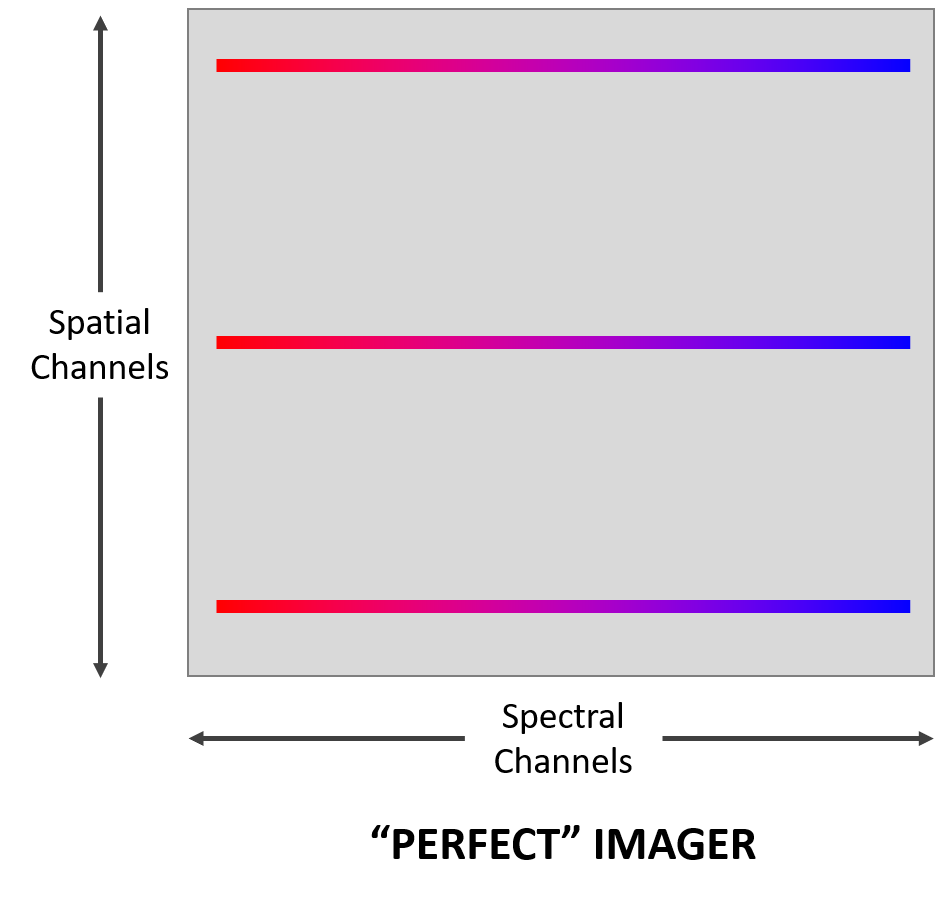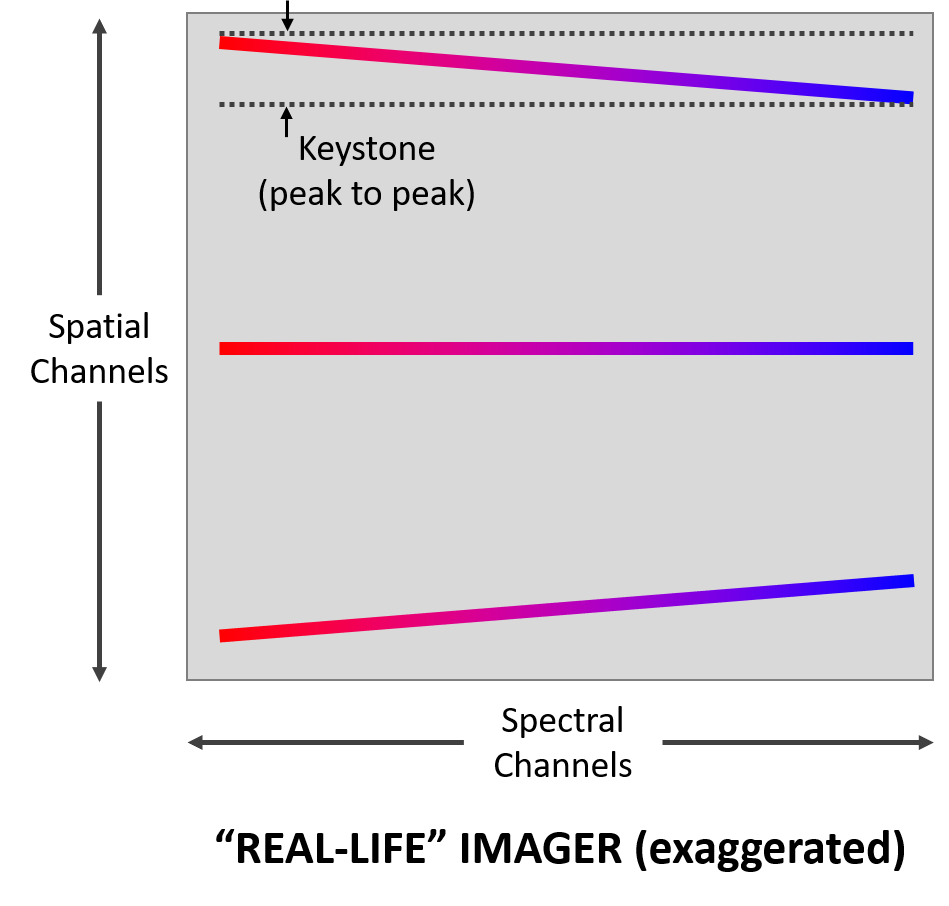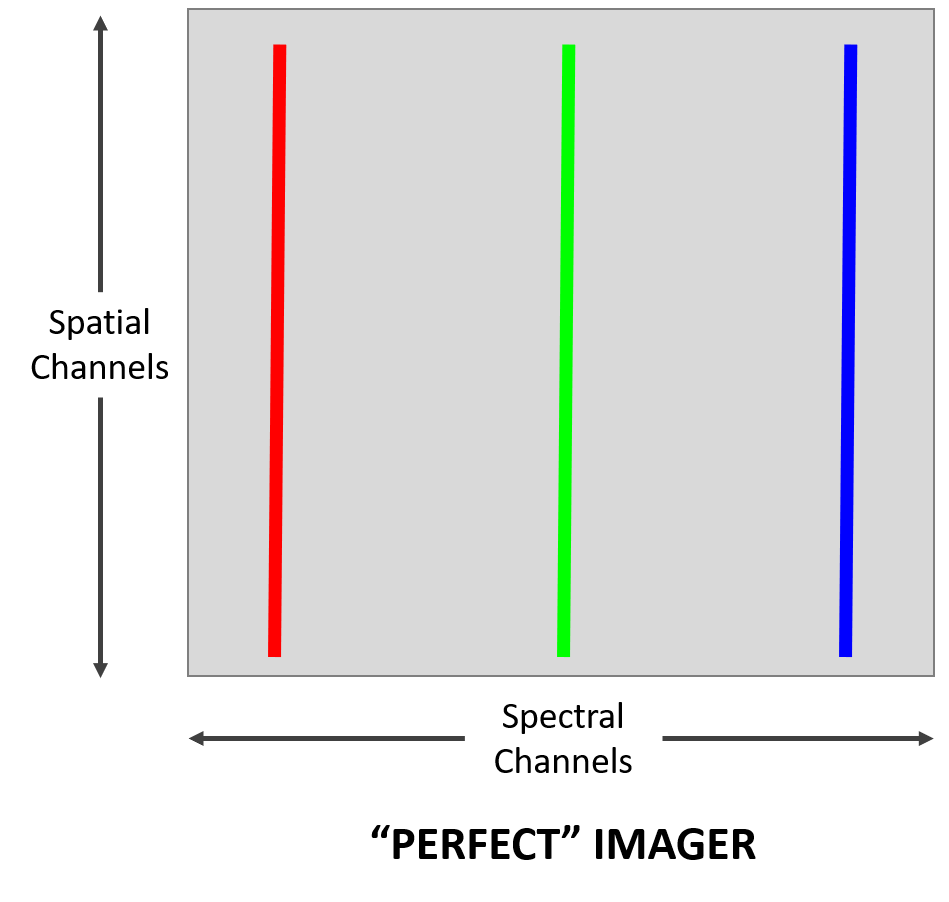12. Glossary of Hyperspectral Imaging Terminology¶
- Average RMS Spot Radius:¶
Measure of the imager resolution, averaged across its spectral range.
- Binning:¶
Process by which multiple pixels are lumped together in a single spatial or spectral channel to increase signal, and signal-to-noise ratio. The tradeoff is a loss in spatial or spectral resolution.
- Bit Depth:¶
The resolution of the data recorded for each pixel. For example, a Bit Depth of 12 means that each signal acquisition is stored as one of 212 = 4096 discrete values.
- Datacube:¶
The complete data associated with a hyperspectral scan including the light intensity at each wavelength, at each pixel in a scan. Similar to RGB images, datacubes have two spatial dimensions and one spectral dimension. However, the spectral dimension contains light intensity for each of hundreds of color channels (as opposed to only three colors in RGB images). Datacubes are accompanied by metadata that store additional information about the datacube (e.g., the size of each dimension and the spectral wavelengths).
- Dispersion per Pixel:¶
Range of wavelengths captured by each pixel.
- f/#:¶
f/# is a measure of the lens speed, and is a quantity that is needed to determine the optical system’s radiometric performance. f/# for a hyperspectral imager means the same as it does for a conventional camera.
- Image:¶
Typically, an RGB rendering of a datacube using three distinct spectral channels (among hundreds) to create a visually meaningful image for the user. An image can also be a gray-scale rendering of a datacube utilizing a single wavelength. Finally, the term image can apply to any pixel map created from the datacube, or the result of an analysis of that datacube, such as a heat map or a color-coded pixel classification.
- Keystone Distortion (peak-to-peak):¶
Keystone is an optical distortion associated with hyperspectral imagers that manifests when light from a single spatial position falls across different spatial rows of the focal plane array for different spectral channels. The figures show how a “perfect” hyperspectral imager would map the signal from three spatial channels, one at the top of the field of view, one in the middle, and one at the bottom, along with an exaggeration of the signal that a “real-life” imager maps the same signal. The peak-to-peak Keystone is the distance between the dashed lines, measured in pixels. All real hyperspectral imagers have some Keystone, which causes the signal to be “mixed” between spatial channels.


- Max. Frame Rate:¶
The maximum line-scan rate of the hyperspectral imager, assuming adequate lighting. It is the rate at which the imager can acquire lines, (not complete scans). The total scan time depends on the number of lines recorded in a complete two-dimensional image.
- Peak SNR:¶
Peak Signal to Noise Ratio.
- Pixel Size:¶
The center-to-center physical distance between pixels on the sensor array.
- Pixel Well Depth:¶
The maximum number of electrons a pixel can store before saturating.
- Slit Width:¶
The width of the slit through which light passes as it enters the spectrometer.
- Smile Distortion (peak-to-peak):¶
Smile is an optical distortion associated with hyperspectral imagers that manifests when light from a single wavelength falls across different spectral columns of the focal plane array for different spatial channels. The figures show the signal that a “perfect” hyperspectral imager would obtain for a uniformly lit sample with narrow-band red, green, and blue signal, along with an exaggeration of the signal that a “real-life” hyperspectral imager obtains. Peak-to-peak Smile for the red signal is the distance between the black vertical lines. All real hyperspectral imagers have some Smile, usually measured in pixels. Smile leads to spectral signatures that change slightly across different spatial channels.


- Spatial Pixels:¶
Resonon’s hyperspectral imagers are line-scan or push-broom imagers. The Spatial Pixels are the number of pixels along this line.
- Spectral Bandwidth:¶
The width of each spectral data point. Equal to the spectral range divided by the number of spectral channels.
- Spectral Channels:¶
The number of wavelength bands that the hyperspectral imager measures across the Spectral Range.
- Spectral Pixels:¶
The number of sensor pixels across which the spectral range is recorded. This is not equal to the number of spectral channels, as several pixels may be used together to record the light intensity at a single spectral channel.
- Spectral Range:¶
The range of electromagnetic wavelengths (e.g. light) over which the hyperspectral imager collects signal. For reference, visible wavelengths span from approximately 400 to 700 nanometers (nm).
- Spectral Resolution (FWHM):¶
The full-width/half-max of the spectral intensity distribution of a single wavelength input. Spectral Resolution (FWHM) is a measure of the spectral focusing ability of the instrument.
- Spectral Sampling:¶
The spectral range divided by the (number of) spectral pixels. It is often narrower than the spectral resolution.
- Spectrometer Magnification:¶
Ratio between the slit image width on the sensor array and the physical slit width.
- Spectrum:¶
A Two-dimensional graphical representation of the light intensity versus wavelength recorded for a single pixel.
